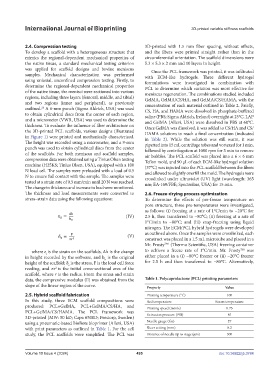Page 503 - IJB-10-4
P. 503
International Journal of Bioprinting 3D-printed variable stiffness scaffolds
2.4. Compression testing 3D-printed with 1.5 mm fiber spacing, without offsets,
To develop a scaffold with a heterogeneous structure that and the fibers were printed straight rather than in the
mimics the regional-dependent mechanical properties of circumferential orientation. The scaffold dimensions were
the native tissue, a standard mechanical testing criterion 5.3 × 5.3 × 2 mm and 10 layers in height.
was applied for scaffold designs and bovine meniscus Once the PCL framework was printed, it was infiltrated
samples. Mechanical characterization was performed with ECM-like hydrogels. Three different hydrogel
using uniaxial, unconfined compression testing. Firstly, to formulations were investigated in combination with
determine the regional-dependent mechanical properties PCL to determine which variation was most effective for
of the native tissue, the menisci were sectioned into various meniscus regeneration. The combinations studied included
regions, including three layers (femoral, middle, and tibial) GelMA, GelMA/CS/HA, and GelMA/CS/HAMA, with the
and two regions (inner and peripheral), as previously concentration of each material outlined in Table 2. Briefly,
outlined. A 6-mm punch (Sigma Aldrich, USA) was used CS, HA, and HAMA were dissolved in phosphate-buffered
28
to obtain cylindrical discs from the center of each region, saline (PBS; Sigma Aldrich, Ireland) overnight at 25°C. LAP
and a micrometer (VWR, USA) was used to determine the and GelMA (Allevi, USA) were dissolved in PBS at 60°C.
thickness. To evaluate the influence of fiber architecture on Once GelMA was dissolved, it was added to CS/HA and CS/
the 3D-printed PCL scaffolds, various designs (illustrated HAMA solutions to reach a final concentration (indicated
in Figure 1) were printed and mechanically characterized. in Table 2). While the solution was still warm, it was
The height was recorded using a micrometer, and a 9-mm pipetted into 15 mL centrifuge tubes and vortexed for 1 min,
punch was used to obtain cylindrical discs from the center followed by centrifugation at 1000 rpm for 3 min to remove
of the scaffolds. For both meniscus and scaffold samples, air bubbles. The PCL scaffold was placed into a 6 × 6 mm
compression data were obtained using a Tinius Olsen testing Teflon mold, and 90 µL of each ECM-like hydrogel solution
machine (H25KS; Tinius Olsen, USA), equipped with a 100 (37°C) was injected into the PCL scaffold between the fibers
N load cell. The samples were preloaded with a load of 0.5 and allowed to slightly overfill the mold. The hydrogels were
N to ensure full contact with the sample. The samples were crosslinked under ultraviolet (UV) light (wavelength: 365
tested at a strain rate of 0.5 mm/min until 20 N was reached. nm; EA-160/FBE; Spectroline, USA) for 15 min.
The change in thickness and increase in load were monitored.
The thickness and load measurements were converted to 2.6. Freeze-drying process optimization
stress–strain data using the following equations: To determine the effects of pre-freeze temperature on
pore structure, three pre-temperatures were investigated,
as follows: (i) freezing at a rate of 1°C/min to −20°C for
(IV) 2.5 h, then transferred to −80°C; (ii) freezing at a rate of
1°C/min to −80°C; and (iii) snap-freezing using liquid
nitrogen. The ECM/PCL hybrid hydrogels were developed
as outlined above. Once the samples were crosslinked, each
(V) construct was placed in a 1.5 mL microtube and placed in a
Mr. Frosty TM (Thermo Scientific, USA) freezing container
TM
where ε is the strain on the scaffolds, Δh is the change to achieve a freeze rate of 1°C/min. Mr. Frosty was
s
in height recorded by the software, and h is the original either placed in a (i) −80°C freezer or (ii) −20°C freezer
o
height of the scaffold; δ is the stress, F is the load cell force for 2.5 h and then transferred to −80°C. Alternatively,
s
reading, and πr is the initial cross-sectional area of the
2
scaffold, where r is the radius. From the stress and strain
data, the compressive modulus (E) was obtained from the Table 1. Polycaprolactone (PCL) printing parameters
slope of the linear region of the curve. Property Value
2.5. Hybrid scaffold fabrication Printing temperature (°C) 100
In this study, three ECM scaffold compositions were Bed temperature Room temperature
produced: PCL+GelMA, PCL+GelMA/CS/HA, and Printing speed (mm/s) 0.75
PCL+GelMA/CS/HAMA. The PCL framework was Extrusion pressure (PSI) 85
3D-printed (MW: 50 kD; Capa 6500D; Perstorp, Sweden)
using a pneumatic-based BioBots bioprinter (Allevi, USA) Needle gauge (Ga) 27
with print parameters as outlined in Table 1. For the cell Slicer setting (mm) 0.2
study, the PCL scaffolds were simplified. The PCL was Distance of needle tip to stage (µm) 300
Volume 10 Issue 4 (2024) 495 doi: 10.36922/ijb.3784

